Toledo - the "Melting Pot" of the Christians, Jews and Muslims

A visit to Madrid is very diversified and transmits some fascinating impressions. In order to round this, some different destinations for an excursion in the surroundings of Madrid that are at approximately one hour distance from the Spanish capital are very recommendable. The excursions give an insight into the valued history of the whole area around Madrid, they give a different perspective as one sees more than only Madrid and one has the opportunity to experience some unique buildings and nature like no other elsewhere.
Occidental churches, very narrow alleyways and a moorish building style that is common in almost all buildings in the centre - Are we in an Arabian country? Almost; Geographically, we are in Toledo, in one of the oldest cities of Spin at approximately 70 kilometres southwest from Madrid. Toledo offers a unique history on which numerous buildings and museums remind to.
An historical overview
Toledo waa the capital of the Iberian Carpetians, the Romans 192 B.C. who called Toledo "Toletum" and finally the Visigoths 534 - 712.
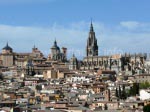
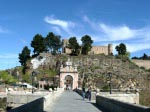
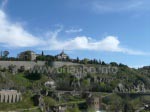
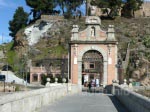
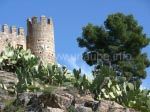
In the year 712, Arabian troups took over the control over "Tolaitola". Also Jews and Christians lived there together in peace. The governing Arabians initiated the building of mosques, koran schools and a lot of Arabian arquitecture. But despite this, there was freedom of belief and respect to each other - a way of living that is wished by a lot of people these days but consider it utopian. Up to the year 1580, the official language was Arabian ; some words still exist in the Spanish language, as for example the word "almohada" (long cushion). The significance of the city Toledo grew by economical prosperity. The weapon factory and the silk production were specially prestigious. Still today, the steel blades and golad and silver inlays of Toledo are very famous and appreciated as tradition.
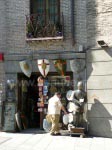
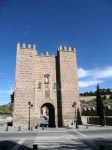
The traces of the inhabitants of that time are, as said before, still visible today. The narrow alleyways, the many blind alleys and high houses re surely not recmendable for cars - but very attractive to the eye. The high houses, the barred windows and heavy doors give a feeling as being placed into the past. Contrary to that time, the touristical infrastructure of Toledo grew significantly. There are souvenir shops in many corners that often offer swords and knight equipment - whoever might need this.
Sightseeings of Toledo
In order to visit the sightseeings the best is to get a city map at one of the tourist information centres; it is the best way to coordinate the tour; Which sightseeings are specially recommendable?
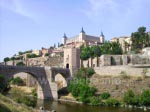
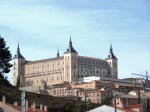
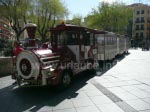
From a distance, the Alcazar and the Cathedral of Toledo already raise up, two buildings with history. The Alcazar is the highest point of Toledo and is located close to the Plaza Zocodover, that in former times already was the centre of the city: meetings, markets and executions took place here in the eyes of the crowd. The Alcazar was built in the 16th century and with its strict building style it reminds a little on the convent of governance of the Escorial. A war school was accommodated in it and today, it contains some uniforms and collections of weapons.
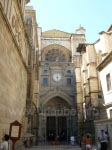
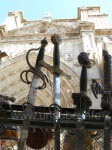
The cathedral that apparently is the second most important gothic church of the whole of Spain is located at the Plaza de Ayuntamiento that is named after the city hall (Ayuntamiento). In fact, it was built from the year 1227 up to 1493, a thing tha tis certianly not surprising cnsidering the dimensions and the valued arrangement: it measures a length of 100 metres with 5 church naves; At the left side of the main portal, the poor people were provided with food, this where the name milk-bread-door (Puerta de Mollete) comes from.
As it is the case in many cathedrals, here are also a lot of paintings to see, specially in the sacristy: famous painters as El Greco, Francisco de Goya, Mengs and Van Dyck have pinted some biblic scenes. The capture of Christ was a popular motif in which the painters gave free reins to their imagination.
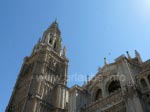
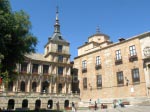
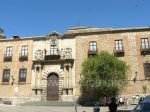
The choir is well worth seeing with its wood craft. Involuntarily, the question of how long it had been chipped on this work raises, in which the conquest of Granada and biblic scenes are represented. In the cathedral, the cathedral's treasury that is highly visible is specially famous.
Not only the Arabian but also the Jewish inhabitants have left their traces as in the former jewish district named Plaza de Conde. What is well worth seeing in this district is the church Santo Tomé, the Museo El Greco and the synagoge Transita that is located a little distant. The church Santo Tomé was originally a mosque, but then it was rearranged to a gothic church. The Casa and Museo El Greco is a typical residential house of Toledo, where there is still the furniture and numerus artworks of the painter. But it is uncertain if he really lived there; the actual owner was the Jewish son of a bankier Samuel Ha-Levi, after whom the street is named.
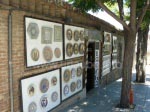
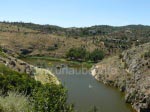
Passing all the art shops that - as the most of them also offer, beside porcelain, fans and drapery, the famous swords - one gets to the synagoge Tránsito. It was donated by Samuel Ha-Levi and also has a small museum that shows the history of the Jewish in Spain and typical rituals as lso items. In the upper floor, the life cicle from the birth to the growth and wedding up to death is described with a lot of traditions.
The silent singing in the entrance hall is specially nice and provides a special ambience. Otherwise, the Tránsito appears rather as a museum than a synagoge, but it is in any case worthwhile visiting. At the right side of the exit, there is a nice view to the river, to the rocks and dried plants - as nice s a view can be at 38°C.
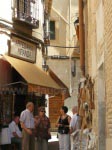
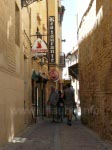
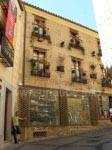
Among the numerous sightseeings, I would like to mention at the end the Museo de Santa Cruz and the Hospital de Tavera. The Museo de Santa Cruz shows excavations of the Romans ans Visigoths - real archaeological treasures. Moreover,there are many paintings of Goya and El Greco as also arts in form of sculptures, glass and ceramics to see.
The Hospital de Tavera was built in the year 1599 and named after the cardinal Tavera, his donator. The hospital is a private museum in which one can view the church and some housing space with a lot of art paintings.
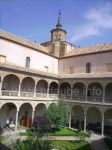
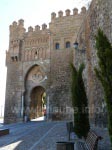
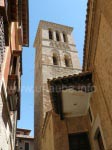
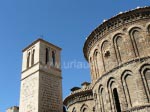
After so many viewings one really deserved a break - specially the visit in the summer time is strongly exhausting. Fortunately, there are some park complexes outside the city centre that invite to have a siesta before getting back to Madrid.
More Informtion about Toledo
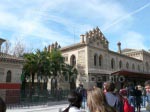
There are several ways to get to Toledo. The fastest way is by train from the subway station Atocha (L1) in Madrid. But the bus just needs a little longer and departs from the Estación Sur at the subway station Méndez-Alvaro (L6). Those who rent a car will get to Toledo over the road N V in direction to Talavera and the N 401.
On Sundays and Mondays, a lot of sightseeings close; the same applies for the midday breaks. Those who want to visit Madrid and the surroundings in the summer time will have to consider extremly high temperatures (in Toledo, the heat is even more extrem than in Madrid), so that one has to use a strong sun protection and drink a lot of water.

Back to the index Madrid
Author: Stefanie Kotulla; Copyright 2008-2008: Patrick Wagner, www.tourist-guide.biz
|